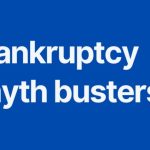KEY POINTS
• Bankruptcy might feel like you’re at financial rock bottom but it’s actually a chance to start afresh.
• There’s plenty of misconceptions around bankruptcy, which is why it’s important to speak with a personal insolvency specialist.
• Personal insolvency numbers are expected to rise towards pre-COVID levels over the next two years.
• Truth and transparency are critical to the bankruptcy process.
One of the first questions we get when people talk to us about bankruptcy is, “Will I lose all of my income and assets?” The answer is no.
Sadly, such myths mean a lot of financially distressed individuals try to battle on because they’re scared of what they think personal insolvency (bankruptcy) means. As a result, they can get further and further into debt and emotional turmoil. That’s why it’s best to speak with personal insolvency specialists – bankruptcy trustees – to make sure you get clear guidance, understand what’s involved in the process and, should you proceed, ensure everything is handled correctly and, ultimately, the financial pressure is eased.
The Australian Financial Security Authority (AFSA) predicts personal insolvency numbers will rise towards pre-COVID levels over the next two years, particularly due to cost of living pressures and wider economic uncertainty. That’s certainly ringing true; my fellow bankruptcy trustees and I have had more calls in recent months than in the past few years. We understand it’s hard for people to face the fact they might need to file for bankruptcy. But while it might feel like rock bottom, it’s actually a chance to start afresh and to get out of a financial – and often emotional – hole. Bankruptcy can give people a second chance.
The personal insolvency process involves a series of steps and procedures that must be followed. Truth and transparency are critical to the bankruptcy process. Another point I’d like to make is that the personal insolvency regime has flexibility embedded in it. For example, there are hardship clauses if you require medical treatment. Which is why speaking with a bankruptcy trustee can give you the information you need to dispel any myths and provide vital support to get you through the process. At the end of the day, you’re dealing with numbers on a page. They aren’t worth the stress on your body, mind and relationships.
Here we look at three common misconceptions around bankruptcy:
1. You can’t earn money when you’re a bankrupt
There’s no limit as to how much you can earn whilst in bankruptcy; however, one-half of a bankrupt’s net income (after tax and other deductions) after a certain threshold will be paid to the bankruptcy trustee, and this amount changes depending on how many dependants you have (see below table). AFSA understands those declaring bankruptcy need to care for their family and dependents – even if you have a split family.
As part of the process, those in bankruptcy must forecast their income contribution levels over 12 months and then report if their income goes over the threshold, which means they then have to top up the contributions.
| Income contributions from the bankrupt person Updated 20 March and 20 September |
|
| Limit, threshold or payment | Amount |
| Base income threshold amount (BITA) | $66,639.30 (after tax) |
| Actual income threshold amount (AITA)
Over this amount, half of any income you get goes towards repaying creditors. The applicable threshold depends on how many dependants you have. Number of dependants |
(all amounts after tax)
$66,639.30 |
| How much someone can earn and still be a dependent (used when calculating income contributions) Updated each financial year |
|
| A person who resides with you and who depends on you for economic support can earn income up to this limit during the income contribution assessment period and still count as your dependant. | $3,975.00 |
2. Will I lose all my assets if I file for bankruptcy?
Many people we speak with think they’ll have to give up all their assets. That’s a fallacy. Assets that fall into the unprotected category include shares, antiques, artwork, lottery winnings, bank balances, cryptocurrency, copyrights, boats and jet skis. Some of the most significant unprotected assets people own include residential or investment properties. It’s also important to note that putting your house into your spouse’s name doesn’t work anymore. If you are working and helping pay the mortgage, it means you, the bankrupt, have an interest in it.
Protected assets typically include superannuation (although there are some special circumstances), general household contents and furniture, some compensation or life insurance payments, tools used to maintain employment (as below), and vehicles (cars or motorbikes) used primarily for transport (as below).
| Protected property: assets a bankrupt person can keep Updated each financial year |
|
| Limit, threshold or payment | Amount |
| Tools: up to this total value, you can keep property used to earn income by physical exertion (tools of trade) | $3,950.00 |
| Vehicles: you can keep cars or motorbikes you use mainly for transport worth up to this amount. If you haven’t paid off this vehicle, the amount that counts towards the limit is its value minus what you still owe. | $8,550.00 |
3. I’ll never be able to apply for credit again
Many feel their borrowing capacity is permanently ruined if they become bankrupt.
Once a bankruptcy has ended (generally three years and one day from when your bankruptcy application was accepted), there’s no restriction on applying for loans or credit.
Credit reporting agencies keep a record of your bankruptcy for:
- Five years from the date you became bankrupt; or
- Two years from when your bankruptcy ends (whichever is later).
| Amount of credit etc. you can get without telling the lender about your bankruptcy or debt agreement Updated quarterly |
|
| Limit, threshold or payment | Amount |
Above this limit, you must disclose that you’re bankrupt or in a debt agreement before you can:
|
$6,624.00 |
| The bankruptcy trustee can lodge an objection if you are bankrupt and engage in misleading conduct relating to amounts that are, or add up to, more than the limit | $6,624.00 |
It’s a criminal offence if you are a bankrupt or subject to a debt agreement to obtain or attempt to obtain credit in certain circumstances. Severe penalties apply to these offences.

Stewart Free
Jirsch Sutherland Partner | Bankruptcy Trustee











